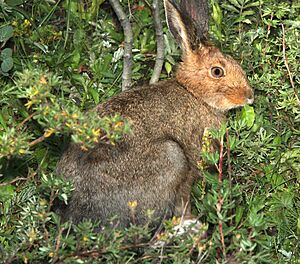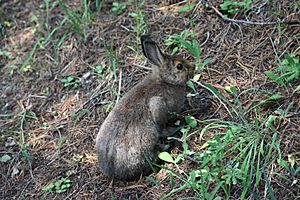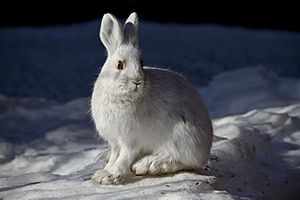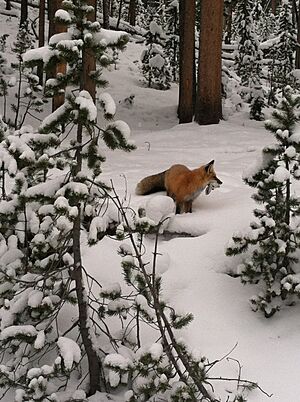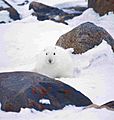Snowshoe hare facts for kids
Quick facts for kids Snowshoe hare |
|
|---|---|
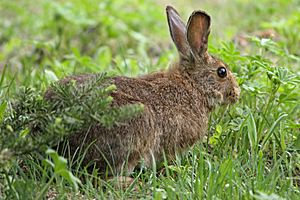 |
|
| Summer coat, photographed in Olympic National Park, Washington | |
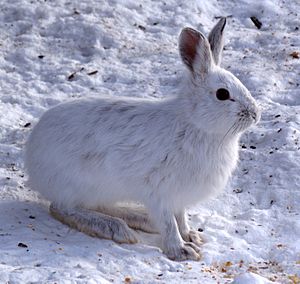 |
|
| Winter coat, photographed near Shirleys Bay, Ontario | |
| Conservation status | |
| Scientific classification | |
| Genus: |
Lepus
|
| Species: |
americanus
|
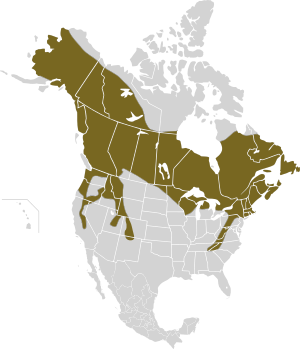 |
|
| Snowshoe hare range | |
The snowshoe hare (Lepus americanus) is a type of hare found in North America. People also call it the varying hare or snowshoe rabbit. It gets its name "snowshoe" because its large back feet work like snowshoes. These big feet stop it from sinking into deep snow. Plus, the fur on its feet keeps them warm in cold weather.
Snowshoe hares are masters of camouflage. Their fur changes color with the seasons. It turns white in winter to blend with snow. In summer, it becomes rusty brown to match the ground and trees. Their sides stay white all year. You can also spot them by the black fur tips on their ears. Their ears are shorter than those of many other hares.
In summer, snowshoe hares eat plants like grass, ferns, and leaves. When winter comes, they munch on twigs, tree bark, and other plants. Sometimes, like the Arctic hare, they might even eat dead animals. They are mostly active at night and do not hibernate.
A main predator of the snowshoe hare is the Canada lynx. For hundreds of years, records from fur hunters have shown how lynx and hare numbers go up and down together. This makes the snowshoe hare a famous example in biology classes. It helps students learn about the relationship between predators and their prey.
Contents
Where Snowshoe Hares Live
Snowshoe hares live across a wide area. You can find them from Newfoundland all the way to Alaska. They also live south in the Sierra Nevada mountains in California. In the Rocky Mountains, they reach southern Utah and northern New Mexico. You can also find them in the Appalachian Mountains down to West Virginia. Sadly, some groups in southern states like Ohio and Maryland have disappeared.
What Snowshoe Hares Look Like
The snowshoe hare's fur changes color with the seasons. It is rusty brown in spring and summer. In winter, it turns white. Their belly is always gray. The tips and edges of their ears and tail are black. They have very large back feet with thick fur on the soles. This fur helps them walk on snow. Their ears are not as long as some other hares' ears.
Snowshoe hares are usually about 41 to 52 centimeters (16 to 20 inches) long. Their tail is about 4 to 5 centimeters (1.5 to 2 inches) long. Their big back feet measure 12 to 15 centimeters (4.6 to 5.8 inches). Their ears are about 6 to 7 centimeters (2.4 to 2.8 inches) from top to bottom. Most snowshoe hares weigh between 1.4 and 1.6 kilograms (3.1 to 3.4 pounds). Male hares are a little smaller than females.
In summer, their fur is a mix of rusty or grayish brown. They have a darker line down their back. Their sides are buffy, and their belly is white. Their face and legs are cinnamon brown. Their ears are brownish with black tips. In winter, their fur is almost completely white. Only their eyelids and ear tips stay black. The fur on their feet is very thick, forming their "snowshoes."
Snowshoe Hare Habitat
Snowshoe hares mostly live in places with lots of plants. These include boreal forests, mountain forests, and wet areas. Sometimes, you might see them in open places like farms.
In Utah, they use areas with Gambel oak trees. In the Southwest, the hares live in the Sangre de Cristo Mountains of New Mexico. Here, they are found in shrubby areas with small trees like Engelmann spruce and juniper.
In Minnesota, snowshoe hares live in both high lands and wet areas. In New England, they like forests that are growing back after being cut down.
Reproduction and Life Cycle
Snowshoe hares are active at night. They are shy and like to keep hidden. During the day, they rest in shallow dips in the ground. These spots are often under ferns, thick bushes, or piles of fallen trees. Sometimes, they even use the burrows of other animals like mountain beavers.
Snowshoe hares are active all year long. Their breeding season starts when new plants begin to grow. This usually happens from late December to January and lasts until July or August. In some areas, like Oregon, males are most active in May. In Ontario, the peak is in May, and in Newfoundland, it's in June. The first baby hares of the year are born from mid-April to May.
A mother hare usually has three to five babies, called leverets, in each litter. Newborn leverets are born with fur, open eyes, and can move around. After leaving their birthplace, the baby hares stay close to each other during the day. They gather once each evening to drink milk from their mother.
The number of litters a female has each year can change. In Alberta, hares had almost three litters per year when their population was high. They had four litters when their population was low. Females usually have their first babies when they are one year old.
What Snowshoe Hares Eat
Snowshoe hares eat many different kinds of plants. What they eat changes with the seasons. In spring and fall, they eat juicy green plants. After the first frost, they mostly eat buds, twigs, evergreen needles, and tree bark. Snowshoe hares usually eat at night. They follow well-used paths in the forest to find their food.
Snowshoe Hare Predators
Many animals hunt and eat snowshoe hares. Their main predator is the Canada lynx. But other animals also hunt them. These include bobcats, fishers, American martens, Pacific martens, long-tailed weasels, minks, foxes, coyotes, domestic dogs, domestic cats, wolves, cougars, and even black bears.
Many birds of prey also hunt snowshoe hares. These include great horned owls, barred owls, spotted owls, other owls, red-tailed hawks, northern goshawks, other hawks, and golden eagles. Even some corvids (like crows) might hunt them. In Glacier National Park, snowshoe hares are hunted by Rocky Mountain wolves.
Snowshoe Hares and Climate Change
The places where some snowshoe hares live are changing a lot. Some areas now have snow for shorter times than before. Some hares have learned to stay brown all winter. But others still turn white in winter. These white hares are in more danger of being hunted. This is because they no longer blend in with their surroundings. Many scientists worry that snowshoe hare numbers might drop sharply. Other animals that rely on the hares for food are also at risk.
Images for kids
See also
 In Spanish: Liebre americana para niños
In Spanish: Liebre americana para niños



